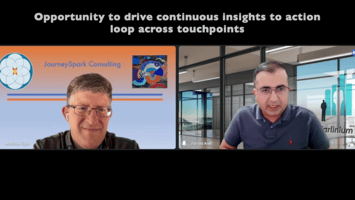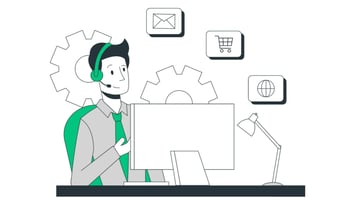In this first of a two-part series, Farzad Aref, Founder and CEO of Farlinium, joins Matt Egol of...
Create a Continuous Improvement Cycle that Leverages Insights to Drive ROI for Your CX (Part 2)
In this second of a two-part series, Farzad Aref, Founder and CEO of Farlinium, joins Matt Egol of JourneySpark Consulting to discuss how to create a continuous improvement cycle that leverages insights to drive ROI for your CX. This conversation is the second in a series focused on leveraging insights at every touchpoint to enhance customer experience and improve business outcomes. You can watch the first one, discussing the "what" here.
Throughout the conversation, Farzad and Matt delve into the significance of capturing and analyzing customer feedback from various channels and technologies, emphasizing the power of unstructured data and natural language understanding. They share their experiences working with Qualtrics' XM Discover platform and discuss the evolution of customer experience measurement and analysis. By watching this video, CX professionals will gain valuable insights into creating a continuous improvement cycle and utilizing data effectively to maximize return on investment for customer experience initiatives. We hope you find it helps you to stay ahead in the dynamic world of CX.
Below is the transcript of the video.
Matt Egol: Thanks, Farzad. I think that was a really powerful set of use cases we talked about for the what. I'd like to talk a little bit more about the how now. How does a company's approach to CX listening need to evolve to leverage some of this unstructured data and AI with Qualtrics?
Farzad Aref: So, first and foremost, the data is there.
I think the practice is there to provide care to customers to do research, and to solicit feedback. A lot of that, I would say, is sitting somewhat in silos amongst different teams, and I think there's a big opportunity to actually break down those silos and really start to bring all of that information together to be able to create one common framework of not just listening, but how you want to measure and, and model output and start to bring more.
Engagement across these different stakeholders to be able to actually work on improvement projects together. So I think the starting point of that is we're, we're always. Working with customers on their maturity model mapping will typically see companies show us the initiative by creating a voice of the customer or a customer experience team that is tasked with bringing all of this information together.
And that's where the Qualtrics XM Discover platform plays in very nicely. They have a lot of different connectivities out of the box to tap into these common data sources that have these customer feedback and conversations. And really, the effort and exercise, of discussions is more around what are we going to do with all of the insights that we're going to get from this?
Or do we have our disciplines in place? Do we have, you know, our teams structured well? And I think that's where I see as the big opportunity as we look at these initiatives.
Matt Egol: So a big part of the how is prioritizing the backlog of use cases you want to work on, getting the teams working on the use cases in a consistent approach.
And just working in an iterative, agile way. So you're always improving and acting on the insights. And then broaden this set of use cases you work on over.
Farzad Aref: Yes, and, and making sure we have executive champions, right? That, that are sponsoring these and that we're introducing or, you know, making sure that these CX measures are also part of the performance metrics that these executives are looking after.
Matt Egol: It sounds like a big part of success is you get what you measure and being able to lay out the business outcomes you want to drive, making the cases actionable, and being able to demonstrate that you're moving the needle on some of these numbers. And having shared accountability for the metrics where there's a, there's a lot of CX is a team sport.
Farzad Aref: Yes, exactly. I mean, what we commonly see is as we get these deployments up, now we have a good understanding of what's happening. What is it that now we're going to do with that? How are we going to prioritize, and who are the teams that we're going to be partnering with? And are those teams' metrics and ambos tied to the outcomes that we want to advocate for?
Matt Egol: Earlier on, we talked about, you know, the opportunity to drive a lot in near-term value in the call center and then the ability to broaden that to other digital interactions and other use cases across the end-to-end customer journey. What are some of the industries that you see this as being most valuable in?
Clearly, healthcare is a place where we've collaborated a lot, and financial services, you know, are, is this relevant in any industry with call centers and a lot of frontline employee interaction?
Farzad Aref: Yeah, we've seen relevancy pretty much in every industry, whether you're in a B2C, business-to-consumer, or a business-to-business model.
On the contact center side, we typically see three angles. One is focused around service, right? So as people are running into issues and need service, how well are you meeting those service needs? Another common one is technical support or a help desk operation. And then the other one that's a fast, emerging growing area is actually the sales side of things, right?
When it comes to essentially onboarding new customers or retaining customers. So those are the typical three focus areas of the contact center. But from a relevancy, it applies to all industries.
Matt Egol: Where should companies focus to get started?
Farzad Aref: I think put together the initiatives, right? Make sure that you're able to actually have the common framework of being able to listen to all these channels, and put some core competency around things that you can actually create efficiencies in. I think in the contact center, the low-hanging fruits are you no longer need to manually disposition calls or take a lot of notes. You want to free up your agent's time to really focus with the customer on the call and not have to degrade the analytics that you get from the notes and the dispositions that they do.
And from a quality management perspective, you really want to free up your quality analysts and not be listening and filling out evaluation forms but actually creating coaching packages that they're working with supervisors and your training teams on how they're managing performance and all of these will create outcomes from a dollar saving as well as a huge outcome from an agent and experience and retention perspective.
Matt Egol: One of the things we talked about throughout our discussion is the ability to link the work to business outcomes and value. And one of the things I'm really excited about is for a number of the things that we've talked about today, the investments can be self-funding.
Because the improvements you're making in your listening and your customer experience actually generates savings in your call volume and your investment in cost of quality and your research and testing that actually pays for the investments many times over. And then all the revenue benefits of retention and customer acquisition and cross-sell, upsell, and pricing are all going to the bottom line.
Farzad Aref: Absolutely, and, and again, it's, it's dollar savings, right? Not so much of a correlation of if this scores up, here's like the dollars we can expect. You're actually watching those savings takes place, right? Because you actually have a operations that has a cost associated with it and creating efficiencies that your company scales, right?
You shave off 15 seconds. Eight seconds from those calls, that's going to have a huge impact. If you reduce the repeat callers calling back in by X percent, you're going to see direct benefit from a ROI perspective. So it's very common to see a multiple of savings as you look at these investments you're making on your analytics infrastructure.
Matt Egol: Well, thank you so much Farzad for really interesting discussion around how to drive value from your investments in CX. I'm excited to be your partner.
Anyone who has questions should feel free to reach out to either Farzad or myself. We look forward to the conversations. And hope this sparked some great ideas for you. Thanks so much.
Farzad Aref: Thank you so much, Matt. Really appreciate the opportunity to have a conversation with you today.




